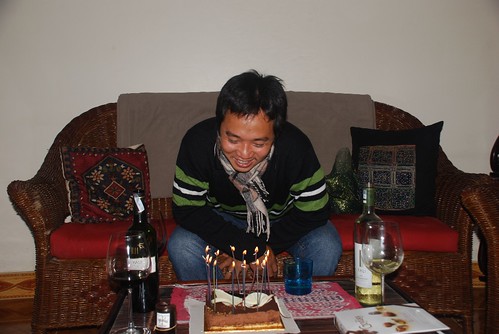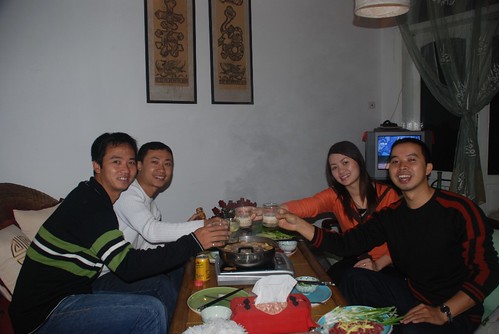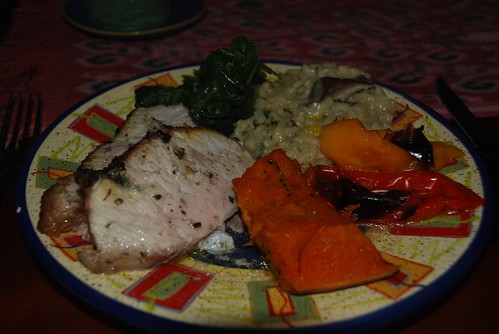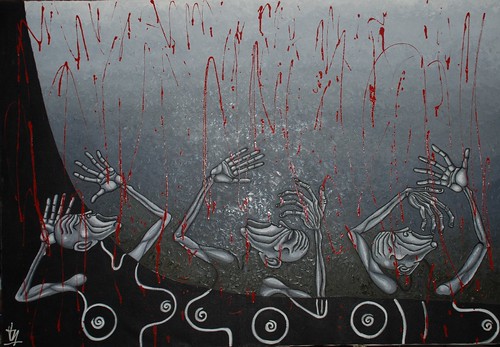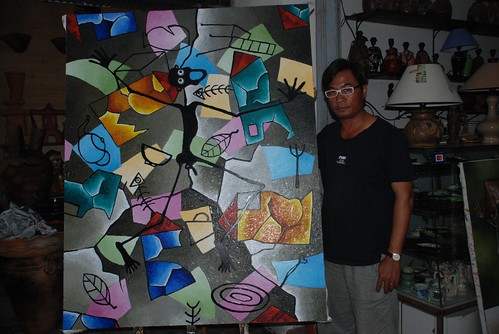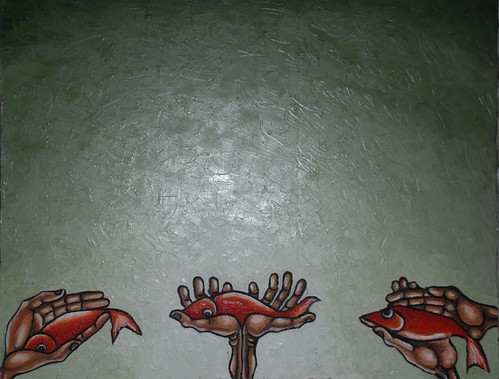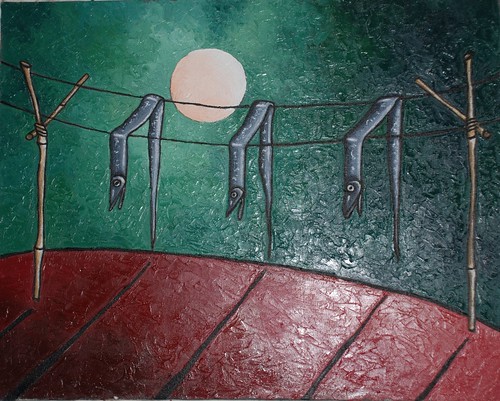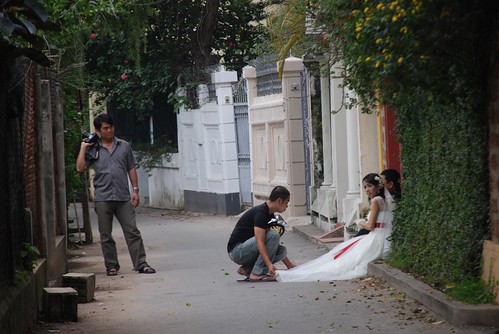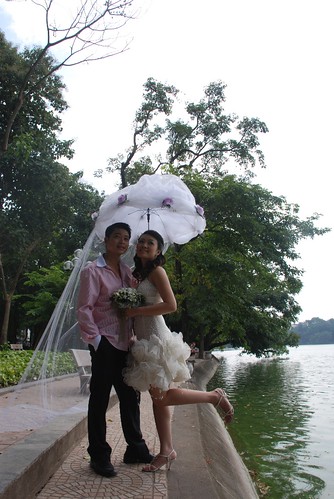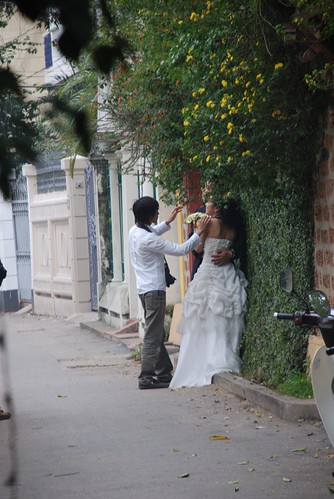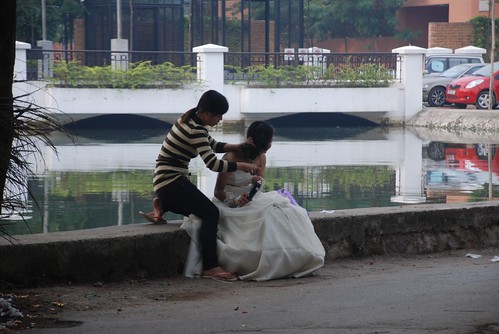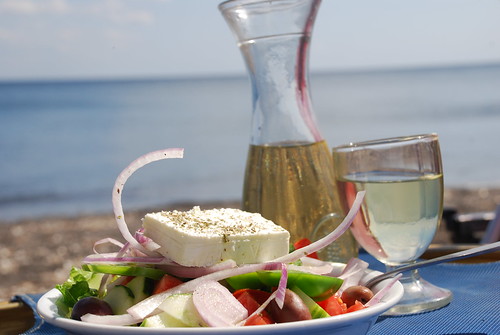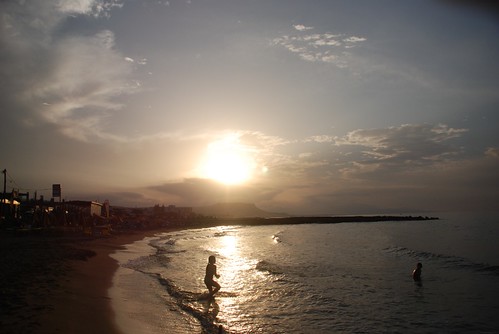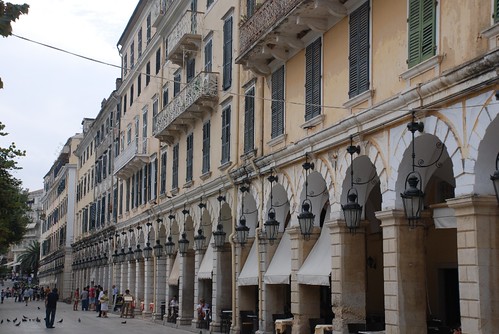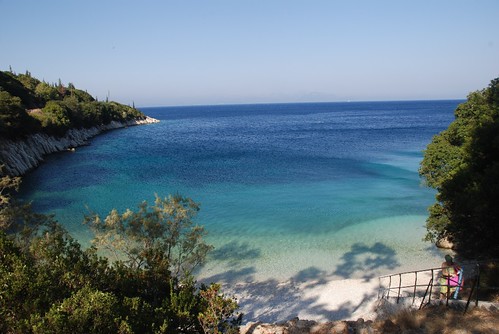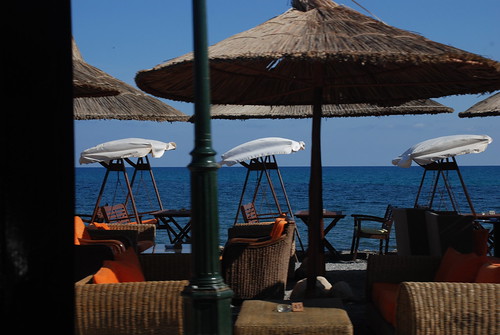It's nice to be 30+ but from now on, I think I will get older and older quicker than I thought. When I was a little boy, thinking about turning 30 years old, it seemed a really long way to go. Looking back from yesterday, Oh my, I'm a few years over it now and it is starting to get scary! Que sera sera is one of my favorite old songs and I suppose there's not much I can do about it.
Anyway, I made a nice beef hotpot with some different mushrooms at home with my close friends for lunch. My friends seemed to enjoy my cooking and we took a few photos at home. I appreciated their coming and some gifts which I told them not to bother about. It was very nice of my friends Sam, Cong and Khai.
In the evening, Viola, another friend who lives near me in Hanoi invited me and some friends over her house to have home made Canadian food for my birthday. It was really nice and quite a surprise for me. I received some gifts and Viola brought a very nice birthday cake and sang birthday songs in different languages. I got a happy shock as I didn't expect that much of a big deal. Thank you very much for making my birthday even more memorable with great food, excellent company with funny stories. I had a great evening.
I was spoiled a little bit but I love that!!!
Wednesday, December 31, 2008
Wednesday, December 17, 2008
Interviewing Mr Minh/ Ty
Craft and cottage industries receive quite a lot of attention in the media in Vietnam. Documentary programs and newspaper articles on the various artisans’ communities and villages around Hanoi are common. Artists who paint images of unisex beings suffering mental and physical torture do not get much press. For many years I had no idea that one of the guys I had been playing tennis with is an accomplished artist.
Born in 1960, Mai Hoang Minh, originally from Hue but currently living in Nha Trang, has produced over 500 paintings in the past 7 years. Minh is a self-taught painter who has not only studied his craft but also the theory and history of art. For 20 years, art has been his passion. A few years ago when I saw his paintings, I thought they were quite difficult to understand and confronting but life is complicated and as I get older I know that people experience all kinds of difficulties in their lives. I suppose Minh's paintings could represent that.
I met him again in Nha Trang recently.
How well-known are you in Vietnam?
My paintings are not as popular in Viet Nam but western people seem to enjoy collecting them. This is probably because I paint very abstractly and Vietnamese generally prefer realism in their art. In Vietnam, art is not emphasized in the education system unfortunately, and visiting art galleries here is mostly a pastime for foreigners.
What media do you work in?
Mostly oil on canvas.
When did you start to take a different direction with your work?
I started painting more abstractly in 2000 to set myself apart from other artists. I wanted to break away from the norm, to make my work stand out. I wasn’t sure how well it would be received as I know my abstract work can be confronting. When I first started painting this way, I knew it would take a while for people to take it seriously. Some people say it is depressing.
Some of the images are quite dark and disturbing. Do you set out to shock people?
No, not at all. I think it is more about awakening. The language of art makes people feel and perhaps face things from their pasts, to maybe realize what is missing. It is true that some people may be shocked and may look for a message or some meaning. I don’t paint with a message or cause in mind – that is more the realm of the people viewing the paintings. Their reactions are individual reactions, not collective ones.
You talked about art as a subject in Vietnam’s education system. What are your views on how art is taught here?
I think the teachers are very much holding onto old methodology and ideas. In art classes here, the teachers force students to follow old rules, to paint old concepts of beauty, like rural scenes and street scenes. But art and the world are things that are constantly evolving and changing. We all view the world in a different way, experience beauty in different things. Creativity needs to be encouraged and rewarded, regardless of traditional concepts of beauty.
What advice would you give to young students currently studying art?
My advice would be to embrace and learn all of the technical knowledge and skills that they can from school art classes but be bold enough to break the rules to follow their individual creative paths. It may take longer to succeed but persistence is necessary, particularly in the arts.
You mentioned that your work receives attention from foreign art lovers. Can you talk about that?
Well, I’ve been lucky enough to exhibit outside Vietnam on several occasions. I’ve had individual shows in California and Colorado. In France, too, in a town called Valenciennes in the north. At the moment I have several paintings in a show at the Fresno Discovery Museum in California.
Minh’s work can be viewed at his studio in Nha Trang (4 Nguyen Thien Thuat St).
Minh's website: www.typainter.com
Born in 1960, Mai Hoang Minh, originally from Hue but currently living in Nha Trang, has produced over 500 paintings in the past 7 years. Minh is a self-taught painter who has not only studied his craft but also the theory and history of art. For 20 years, art has been his passion. A few years ago when I saw his paintings, I thought they were quite difficult to understand and confronting but life is complicated and as I get older I know that people experience all kinds of difficulties in their lives. I suppose Minh's paintings could represent that.
I met him again in Nha Trang recently.
How well-known are you in Vietnam?
My paintings are not as popular in Viet Nam but western people seem to enjoy collecting them. This is probably because I paint very abstractly and Vietnamese generally prefer realism in their art. In Vietnam, art is not emphasized in the education system unfortunately, and visiting art galleries here is mostly a pastime for foreigners.
What media do you work in?
Mostly oil on canvas.
When did you start to take a different direction with your work?
I started painting more abstractly in 2000 to set myself apart from other artists. I wanted to break away from the norm, to make my work stand out. I wasn’t sure how well it would be received as I know my abstract work can be confronting. When I first started painting this way, I knew it would take a while for people to take it seriously. Some people say it is depressing.
Some of the images are quite dark and disturbing. Do you set out to shock people?
No, not at all. I think it is more about awakening. The language of art makes people feel and perhaps face things from their pasts, to maybe realize what is missing. It is true that some people may be shocked and may look for a message or some meaning. I don’t paint with a message or cause in mind – that is more the realm of the people viewing the paintings. Their reactions are individual reactions, not collective ones.
You talked about art as a subject in Vietnam’s education system. What are your views on how art is taught here?
I think the teachers are very much holding onto old methodology and ideas. In art classes here, the teachers force students to follow old rules, to paint old concepts of beauty, like rural scenes and street scenes. But art and the world are things that are constantly evolving and changing. We all view the world in a different way, experience beauty in different things. Creativity needs to be encouraged and rewarded, regardless of traditional concepts of beauty.
What advice would you give to young students currently studying art?
My advice would be to embrace and learn all of the technical knowledge and skills that they can from school art classes but be bold enough to break the rules to follow their individual creative paths. It may take longer to succeed but persistence is necessary, particularly in the arts.
You mentioned that your work receives attention from foreign art lovers. Can you talk about that?
Well, I’ve been lucky enough to exhibit outside Vietnam on several occasions. I’ve had individual shows in California and Colorado. In France, too, in a town called Valenciennes in the north. At the moment I have several paintings in a show at the Fresno Discovery Museum in California.
Minh’s work can be viewed at his studio in Nha Trang (4 Nguyen Thien Thuat St).
Minh's website: www.typainter.com
Monday, December 08, 2008
Pre-wedding Photos
Now that summer is over, Hanoi’s unofficial wedding season is noticeably underway and most wedding photographers are busily snapping pictures at their favourite locations around town.
The wedding season in Hanoi encompasses autumn through to spring. While weddings are occasionally observed in the summer, the heat makes them pretty uncomfortable for all concerned. Lucky wedding days recommended by fortune-tellers are determined by complicated equations involving the lunar calendar birth dates of the couple and other family factors. In addition, certain days are simply considered bad luck. The result is that, throughout the season, there will be days when no-one gets married and days when it seems every one is. Cars covered in fresh flowers, unusually shaped pink and white balloons, busy hotel function rooms, woman dressed in ao dai (long dress) and rented blue tents adjoining houses are the symbols of these days.
In Vietnam, unlike in the west, the wedding photographs are taken in advance of the wedding, not on the actual day of the ceremony. Young couples approach a ‘one-stop-shop’ wedding parlour where gowns and suits can be rented and photographs taken. There are studios with romantic back-drops or the couple may choose to go on a shoot to one of several popular locations. On the steps of Hanoi’s Opera House is perhaps the prime location. Sometimes there are several couples posing in the vicinity at the same time. Hanoi’s crumbling French colonial buildings provide also provide an aura of rustic charm. Other popular spots for wedding photographs include gardens, parks and lakesides.
In my area just near the Intercontinental Hotel at West Lake, the wedding traffic is congested from as early as 7am. There are frequently three or four couples around and once I counted eight. This does become annoying for the local residents, especially considering that each couple is accompanied by four or five staff from the photography studio. Props and costume changes also clutter up the narrow laneways. The photographers’ assistants often have the bride-to-be’s dress spread across the alley. I often wander if the dresses have ever been ridden over! I was embarrassed recently while, when taking my dog for a walk, he lifted his leg on the train of one of the gowns!
These shoots often involve costume changes where the woman goes from western style white to red, pink or purple to traditional Vietnamese ao dai (long dress). The fashion for the men is often very flamboyant, with white suits seemingly very popular this year. I saw one groom posing with a white violin the other day. Sitting astride a classic motorbike is another appealing prop. Interestingly, the costume changes occur just inside the gate of the pagoda nearby! There doesn’t seem to be any opposition from the monks or nuns but to me it seems a bit inappropriate.
By the end of the day on these shoots, it’s interesting observing the general appearance and demeanour of the couples. No-one’s smiling, the hems of the dresses are grubby and the flowers in the brides’ hair are wilting.
I’m sure the photographs are stunning but I often wander how their marriages will turn out!
The wedding season in Hanoi encompasses autumn through to spring. While weddings are occasionally observed in the summer, the heat makes them pretty uncomfortable for all concerned. Lucky wedding days recommended by fortune-tellers are determined by complicated equations involving the lunar calendar birth dates of the couple and other family factors. In addition, certain days are simply considered bad luck. The result is that, throughout the season, there will be days when no-one gets married and days when it seems every one is. Cars covered in fresh flowers, unusually shaped pink and white balloons, busy hotel function rooms, woman dressed in ao dai (long dress) and rented blue tents adjoining houses are the symbols of these days.
In Vietnam, unlike in the west, the wedding photographs are taken in advance of the wedding, not on the actual day of the ceremony. Young couples approach a ‘one-stop-shop’ wedding parlour where gowns and suits can be rented and photographs taken. There are studios with romantic back-drops or the couple may choose to go on a shoot to one of several popular locations. On the steps of Hanoi’s Opera House is perhaps the prime location. Sometimes there are several couples posing in the vicinity at the same time. Hanoi’s crumbling French colonial buildings provide also provide an aura of rustic charm. Other popular spots for wedding photographs include gardens, parks and lakesides.
In my area just near the Intercontinental Hotel at West Lake, the wedding traffic is congested from as early as 7am. There are frequently three or four couples around and once I counted eight. This does become annoying for the local residents, especially considering that each couple is accompanied by four or five staff from the photography studio. Props and costume changes also clutter up the narrow laneways. The photographers’ assistants often have the bride-to-be’s dress spread across the alley. I often wander if the dresses have ever been ridden over! I was embarrassed recently while, when taking my dog for a walk, he lifted his leg on the train of one of the gowns!
These shoots often involve costume changes where the woman goes from western style white to red, pink or purple to traditional Vietnamese ao dai (long dress). The fashion for the men is often very flamboyant, with white suits seemingly very popular this year. I saw one groom posing with a white violin the other day. Sitting astride a classic motorbike is another appealing prop. Interestingly, the costume changes occur just inside the gate of the pagoda nearby! There doesn’t seem to be any opposition from the monks or nuns but to me it seems a bit inappropriate.
By the end of the day on these shoots, it’s interesting observing the general appearance and demeanour of the couples. No-one’s smiling, the hems of the dresses are grubby and the flowers in the brides’ hair are wilting.
I’m sure the photographs are stunning but I often wander how their marriages will turn out!
Tuesday, December 02, 2008
Greece, Adio
Five weeks is definitely not enough time to discover all of Greece, a country with hundreds of beautiful islands surrounded by amazing beaches. I have so many fond memories of my time in Greece and really feel as if I've broadened my horizons. It was my first time in Europe and I really got a feeling for ancient history and the different lifestyle and culture there.
Apart from discovering new places in Greece, here are the things I'd go back for:
1. I'd love to go back to Santorini again to have a glass of local wine and see the sunset and the light against the Cycladic architecture.
2. Corfu's Old Town is definitely worth another wander around, having a pita gyros and looking around the beautiful shops.
3. I would love to return to Ithaki's clear waters and stony beaches to have a nap in the sun after eating a Greek salad and drinking a carafe of the local wine.
4. The view of Athens from the Acropolis.
5. Crete's old capital, Hania, with its restaurants and beautiful artisans shops.
Apart from discovering new places in Greece, here are the things I'd go back for:
1. I'd love to go back to Santorini again to have a glass of local wine and see the sunset and the light against the Cycladic architecture.
2. Corfu's Old Town is definitely worth another wander around, having a pita gyros and looking around the beautiful shops.
3. I would love to return to Ithaki's clear waters and stony beaches to have a nap in the sun after eating a Greek salad and drinking a carafe of the local wine.
4. The view of Athens from the Acropolis.
5. Crete's old capital, Hania, with its restaurants and beautiful artisans shops.
Subscribe to:
Comments (Atom)
